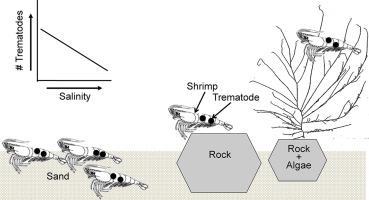Estuarine, Coastal and Shelf Science ( IF 2.6 ) Pub Date : 2021-07-18 , DOI: 10.1016/j.ecss.2021.107508 Jessye S. Kirkham 1 , Michele Guidone 2 , Mary Carla Curran 1

|
The daggerblade grass shrimp Palaemon pugio can be a host for many types of parasites including the microphallid trematode Microphallus turgidus and the haplosporidian hyperparasite Urosporidium crescens. Parasitic infection by trematodes can influence grass shrimp behaviors and may alter habitat selection. We conducted monthly sampling to determine the abundance, density, intensity, and prevalence of M. turgidus and U. crescens at two sites near Savannah, Georgia. The goals of this study were to determine which microhabitat type P. pugio frequented more often, either sandy substrates or rocks with the invasive and habitat altering red alga Agarophyton vermiculophyllum, which was present seasonally, and whether trematode infection corresponded to microhabitat usage. Additionally, we aimed to determine whether temporal changes in parasitic infection correlated to abiotic factors. The results indicated grass shrimp were more likely to be located over sand substrate, even when A. vermiculophyllum was present. Furthermore, the surveys did not detect a relationship between shrimp microhabitat usage and trematode abundance, density, or intensity. All analyzed measures of trematode and hyperparasite infection differed significantly among months with some instances of intraseasonal variation. A negative relationship was detected between salinity and trematode prevalence and mean abundance, but not with temperature. No relationship was observed between salinity or temperature and hyperparasite prevalence or mean abundance. Through consistent monthly sampling of a heterogeneous habitat containing a habitat-altering invasive species, this study supports previous findings that salinity plays a role in M. turgidus abundance within P. pugio and demonstrates that A. vermiculophyllum does not appear to influence host microhabitat preferences, regardless of trematode infection. However, salinity alone cannot account for all observed parasite patterns; thus, it is likely that a combination of fluctuating abiotic conditions, unaccounted for aspects of habitat structure, and the presence of other host species determines grass shrimp risk of parasite infection.
中文翻译:

佐治亚州沿海匕首草虾Palaemon pugio寄生虫感染的时空趋势
匕首草虾Palaemon pugio可以成为许多类型寄生虫的宿主,包括小吸虫Microphallus turgidus和单孢子虫超寄生虫 Urosporidium crescens。吸虫引起的寄生虫感染会影响草虾的行为,并可能改变栖息地选择。我们进行了每月抽样,以确定佐治亚州萨凡纳附近两个地点的M. turgidus和U. crescens的丰度、密度、强度和流行率。本研究的目标是确定哪种微生境类型P. pugio更常出没,无论是沙质基质还是具有侵入性和栖息地改变红藻Agarophyton vermiculophyllum 的岩石,这是季节性存在的,以及吸虫感染是否对应于微生境的使用。此外,我们旨在确定寄生虫感染的时间变化是否与非生物因素相关。结果表明草虾更有可能位于沙质基质上,即使是当A. vermiculophyllum在场。此外,调查没有发现虾微生境的使用与吸虫丰度、密度或强度之间的关系。吸虫和超寄生虫感染的所有分析指标在几个月内有显着差异,有些情况下存在季节性变化。在盐度和吸虫流行率和平均丰度之间检测到负相关,但与温度无关。没有观察到盐度或温度与超寄生虫流行率或平均丰度之间的关系。通过每月对包含改变栖息地的入侵物种的异质栖息地进行一致采样,本研究支持先前的发现,即盐度在P. pugio内的M. turgidus丰度中起作用,并证明A. vermiculophyllum似乎不会影响宿主微生境偏好,无论是否感染吸虫。然而,盐度本身并不能解释所有观察到的寄生虫模式。因此,波动的非生物条件、未考虑栖息地结构方面的因素以及其他寄主物种的存在很可能决定了草虾感染寄生虫的风险。











































 京公网安备 11010802027423号
京公网安备 11010802027423号